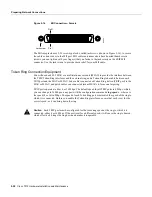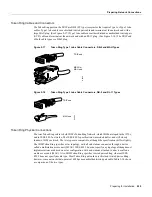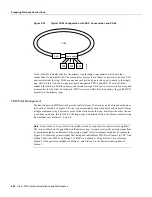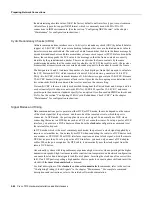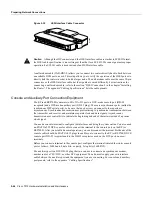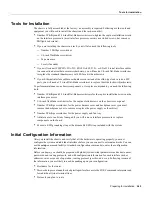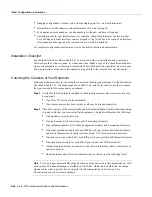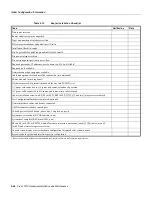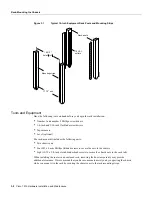
2-40 Cisco 7010 Hardware Installation and Maintenance
Preparing Network Connections
than determining absolute values. NRZ, the factory default on all interface types, is most common.
All interface types also support NRZI format, which is commonly used with EIA/TIA-232
connections in IBM environments. (See the section “Configuring NRZI Format” in the chapter
“Maintenance” for configuration instructions.)
Cyclic Redundancy Checks (CRCs)
All data communications interfaces use a 16-bit cyclic redundancy check (CRC) by default but also
support a 32-bit CRC. CRC is an error-checking technique that uses a calculated numeric value to
detect errors in transmitted data. The sender of a data frame divides the bits in the frame message by
a predetermined number to calculate a remainder or frame check sequence (FCS). Before it sends the
frame, the sender appends the FCS value to the message so that the frame contents are exactly
divisible by the predetermined number. The receiver divides the frame contents by the same
predetermined number that the sender used to calculate the FCS. If the result is not 0, the receiver
assumes that a transmission error occurred and sends a request to the sender to resend the frame.
The designators 16 and 32 indicate the number of check digits per frame that are used to calculate
the FCS. Sixteen-bit CRC, which transmits streams of 8-bit characters, generates a 16-bit FCS.
Thirty-two bit CRC, which transmits streams of 16-bit characters, generates a 32-bit FCS. Because
32-bit CRC transmits longer streams at faster rates, it provides better ongoing error detection with
less retransmits. Both the sender and the receiver must use the same setting.
Sixteen-bit CRC is the most widely used method throughout the United States and Europe, and it is
used extensively with wide-area networks (WANs). IEEE-802 specifies 32-bit CRC, and some
point-to-point transmission standards specify it as an option. It is often used on SMDS networks and
LANs. See the section “Configuring 32-Bit Cyclic Redundancy Check (CRC)” in the chapter
“Maintenance” for configuration instructions.
Signal Modes and Timing
Data communications ports operate in either DCE or DTE mode; the mode depends on the source
of the clock signal that the port uses, and the mode of the remote device to which the port is
connected. In DCE mode, the port supplies its own clock signal. You normally use DCE when
connecting the router to a DTE device such as a PC, host, or another router. To set up a port as a DCE
interface, you must use a DCE adapter cable and use the clockrate configuration command to set
the internal clock speed.
In DTE mode, which is the most commonly used mode, the port uses a clock signal supplied by a
remote or external device. You normally use DTE when connecting the router to a DCE device such
as a modem or CSU/DSU. Most DTE interfaces require an external clock signal, which the remote
DCE device provides. To set up a port as a DTE interface, you need only connect a DTE adapter
cables. When the port recognizes the DTE cable, it automatically uses the clock signal from the
remote DCE device.
Occasionally, systems with long cables may experience high error rates when operating at the higher
transmission speeds. Slight variances in cable construction, temperature, and network configuration
can cause the clock and data signals to shift out of phase. Inverting the clock can often correct this
shift. If an FSIP port is reporting a high number of error packets, suspect a phase shift and invert the
clock with the invert-transmit-clock command.
For brief descriptions of the clockrate and invert-transmit-clock commands, refer to the section
“Configuring Timing (Clock) Signals” in the chapter “Maintenance.” For complete command
descriptions and instructions, refer to the related software documentation.
Содержание TelePresence Server 7010
Страница 10: ...x Cisco 7010 Hardware Installation and Maintenence ...
Страница 14: ...iv Cisco 7010 Hardware Installation and Maintenance Document Conventions ...
Страница 112: ...2 52 Cisco 7010 Hardware Installation and Maintenance Initial Configuration Information Page ________ ...
Страница 148: ...3 36 Cisco 7010 Hardware Installation and Maintenance Using the Flash Memory Card ...
Страница 158: ...4 10 Cisco 7010 Hardware Installation and Maintenance Troubleshooting the Processor Subsystem ...
Страница 242: ...5 84 Cisco 7010 Hardware Installation and Maintenance Replacing Internal Components ...
Страница 258: ...A 16 Cisco 7010 Hardware Installation and Maintenance MIP Interface Cable Pinouts ...
Страница 270: ...B 12 Cisco 7010 Hardware Installation and Maintenance Interface Processor LEDs ...
Страница 274: ...C 4 Cisco 7000 Hardware Installation and Maintenance ...
Страница 287: ...Index 13 ...



